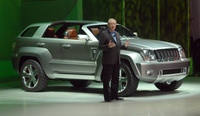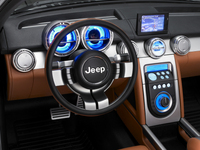2007 Detroit Auto Show - Jeep Trailhawk Unveiled - VIDEO ENHANCED
 Trevor Creed, Senior Vice President - Design, Chrysler Group, unveiled the Jeep® Trailhawk Concept here at the North American International Auto Show today. |
EDITOR'S NOTE: This page contains two embeded videos. The first is the complete Chrysler Concept Press Conference. The second, at the bottom of the page, is a short highlight version of the introductions with running footage.
DETROIT - January 8, 2007: The Jeep Trailhawk concept merges the spectrum of the Jeep brand by combining the core off-road features of the new body-on-frame four-door Jeep Wrangler Unlimited with the refined sophistication of an all-new on-road open-air concept vehicle, providing a unique and fresh expression for Jeep. Built off the new Wrangler platform, the Jeep Trailhawk is a more refined highway cruiser without sacrificing any of Jeep's legendary off-road capabilities.
"The key to the look of the Trailhawk," said Nick Vardis, Principal Exterior Designer, "is the vehicle's distinctive proportions, due in part to its 116-inch wheelbase. The dash-to-front-axle dimension is dramatically long, giving the vehicle a sense of forward motion, while the front and rear overhangs are tight and abbreviated."
Vardis said the body side is muscular and broad-shouldered, with the sheet metal pulled into shape, much like a drawn arrow in the bow of a skilled archer. Even the pillars are pulled back. The forward motion of the body is further accented by the drive of the raising beltline.
The stance is broad, and the wheels, pushed to the corners of the vehicle, are enclosed in robust flares dramatically offset from the body. Partly trapezoidal in shape, yet not asymmetrical, these angular, crisply-contoured wheel flares reinterpret one of Jeep's fundamental design cues.
"The flares are stretched and pulled taut at one end," Vardis said. "Each presents a 'long side' angled toward the center of the body."
The body in turn tapers toward the front in plain view to expose more of the flares and accent the wide stance. The flares enclose large 22-inch, five- spoke wheels, each with a hefty 34-inch overall diameter. The specially- crafted tires are accented by a red stripe, with the red color repeated on the exposed brake calipers.
The lower body, which kicks outward along the bottoms of the doors, intersects the flares crisply. Tucked beneath this horizontal element is a recessed running board, accented by a silver molding. A tall trapezoidal vent, located at the front fender-front door cut line, is home to the circular Trail Rated badge.
The Trailhawk's long hood is fronted by a signature seven-slot Jeep grille angled rearward to match the lean-back surface of the forward flares, with the slots filled with a mesh texture. Bracketed between the grille and the flares, the chamfered headlamps mimic the lean-back stance. Beneath their clear flush lenses, HID projector beam quad lamps nestled into twin "telescopic" polished aluminum barrels light the way forward while LEDs, configured in parallel stripes provide park and turn signals.
"The main headlamp units are cropped diagonally across the top," said Vardis. "They peer out from an angled brow, giving the vehicle its bold, sinister look. In front view, the left and right lamps evoke the hooded eyes of a bird of prey.
"Like other concepts, we first viewed the math surface of the grille and headlamps together in the computer," added Vardis. "We immediately noticed the hawkish expression, hence the name 'Trailhawk.'"
The taillamps mimic the look of the headlamps, including the striped turn signals, with the surface of the liftgate carved away.
The vehicle's upper structure is set onto the lower body, encased by a crisp, chamfered 360-degree molding that runs around the greenhouse, accenting the high, arching beltline. At the base of the windshield is a seven-slot cowl screen that reprises the grille. The body is painted in Argent Pearl high- gloss, with the flares and lower body a slightly darker low-gloss variant.
 |
"The Jeep Trailhawk interior emphasizes the vehicle's open air-freedom, inviting elements of the exterior theme into the interior," said Cliff Wilkins, responsible for the interior design. "Tough mechanical elements which evoke exterior details are contrasted with sophisticated materials and finishes to give a modern, rugged, purposeful interior while delivering a premium off-road experience."
 |
Riding the transmission tunnel, the console's raised walls create a full- length open bin, handy for the storage of sundry items. Within the console's side rails, two front/rear combination armrest/storage bin modules, movable via concealed tracks, can be positioned fore-aft at the occupants' discretion. Using the familiar touchpad technology of laptop computers, a flip-out pad for the remote control fold-away flat screen navigation unit is housed in the forward armrest.
"The open console's unique utility is enhanced by the relocation of the transfer case 'Terrain Selector' switch to the center stack of the I/P," said Wilkins. "Also, there is the use of an electronic gear selector/park brake lever mounted to the right side of the steering column to continue this effect."
Additional storage is available forward of the drop-open center stack control module, and in the lower door trim panels.
The driver and three passengers can relax in individual premium leather seating in Bark Black and Firewood Orange. The vehicle's floor is a durable spray-finish with integrated non-slip heel pads, practical for all-weather use.
In the cargo area, each quarter panel houses a removable, portable "audio pod" sound system. Handsome in their rectangular dark gray cases accented with silver circular speaker bezels, each "pod" is fitted with a dock for an MP3 player. For carrying of first aid or road hazard gear, jerry-can style boxes in easy-to-find Firewood Orange are mounted forward of the speaker "pods."
The utility of the cargo area is enhanced by a drop-down tailgate featuring integral concealed storage, four cup holders, and a sliding Load 'N Go cargo tray with movable partitions that roll rearward for easy retrieval of stored items.
"One of the most remarkable things about the interior," concludes Wilkins, "is that it was designed and surfaced entirely electronically -- there were no traditional sketches or 3-D models. Even so, the interior turned out just as we had envisioned."


